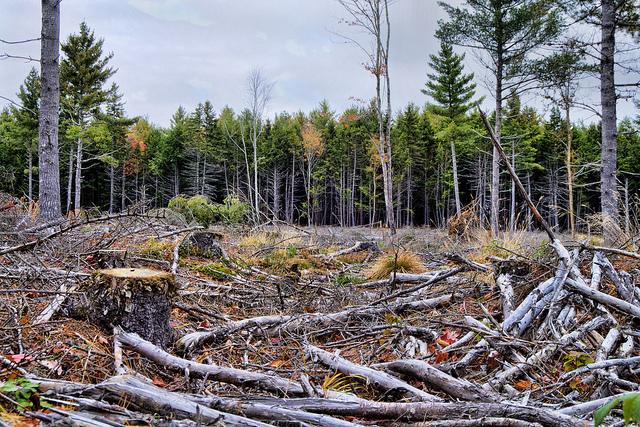You probably saw that recent front-page spread of a big clearcut north of St. Margarets Bay, done more or less by stealth, in the “western lands” that the province bought from the closed Bowater pulp mill for nearly $120 million a couple of years ago — on the understanding that, thanks to innumerable studies, hearings, strategies and sworn commitments to sustainability ongoing for decades, forestry will be done differently from now on in Nova Scotia.
Here’s what’s really going on. We’re in a full-fledged wood-fibre panic — not enough wood in our degraded forest to feed the demand, and so the scheme in the Kremlin-like upper reaches of the Department of Natural Resources (DNR) is to, as secretly as possible and without tipping off anybody, not even other interested parties in their own government and operational people in their own department, hand off those Western lands to Northern Pulp and other big operators. When the fibre panic is on, decades of planning driven by citizen participation can go hang, along with ecological sensitivities.
As usual, the few remaining stands of relatively old-growth trees, as in our front-page clearcut in question, are especially prized for a quick hit.
How can that be, you ask. With Bowater shut down and only two pulp mills remaining, shouldn’t the demand for wood be down generally?
It probably would be, except for a few things. In one of its lousiest moves, the former NDP government created a huge wood-burning “biomass” power plant attached to the pulp mill at Port Hawkesbury, into which 50 truckloads of wood rumble every day. That makes it nearly as much of a guzzler as a pulp mill. It was done in a panic — as usual — to preserve jobs. It also goes into the federal ledger as “renewable” energy, despite being a disaster in every other sense, including being one of the causes of a shortage of wood. The McNeil government should be revisiting this. Plus, companies exporting wood chips are looking for more wood. Plus, small woodlot owners are balking at having their lands devastated by clearcuts. And the pulp companies wiped out most of their own lands a decade ago when prices were high.
The prior problem, however, is DNR. In control are clearcutting fundamentalists who haven’t given an inch, even to the commitments of their own Natural Resources Strategy, developed though years of public consultations and meant to find a balance between environment and harvesting. After Bowater closed, a number of its executives who had represented industry during the Natural Resources Strategy process were recruited by DNR and have, if anything, stiffened its attitudes. The hapless minister, whomever he happens to be, ultimately serves as a mouthpiece.
What to do? There have been calls for “reform” of DNR all along but nothing happens. The department remains more of an arm of industry than of government. Nothing short of breaking up this granitic monolith will do anything. For one thing, DNR both regulates and promotes industry, and those two functions should be split. This is a problem in departments regulating natural resources generally. The Lahey-Doelle panel, for example, recommended a split in those functions in the fishery department regarding aquaculture.
DNR has a number of conservation-related regulatory functions that are essentially in conflict with its industry promotion role, and that it doesn’t take seriously if they impinge on the interests of the logging industry. This is the source of the public’s hostility to, and lack of trust in, the department. These should be hived off and given to the Department of Environment.
They include high-level lands planning, endangered species, game sanctuaries, logging regulations and policy, not to mention the whole wildlife division where, according to my observers, morale is the pits because employees can’t properly do their jobs because they’re forever butting against the pulp company sympathies of the higher-ups.
The department, in short, is functioning badly and is out of sync with the public interest. The question of how we use our forests is actually the second problem. The first problem is getting the policy-making process right so we can fix the second problem, and now it’s not right. As a teaser for the McNeil government, there might even be cost savings in shifting these functions out of DNR. Note to government: check it out.
Those western Crown lands are “the last great wood basket” not committed to pulp companies, says Matt Miller, forestry co-ordinator at the Ecology Action Centre. Despite a progressive western Crown lands plan presented last spring, which includes community forestry projects, he fears DNR is setting up to give out long-term leases to big operators.
“The plan was a test of the government’s commitment to transparency, collaboration and informed decision-making,” he says. “So far, the results aren’t encouraging.”
Ralph Surette is a freelance journalist in Yarmouth County. This column was first published in the Chroncile Herald.
Photo: bambe1964/flickr



